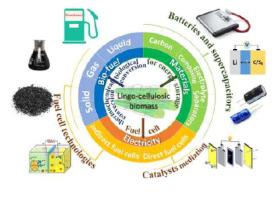Journal of Energy Chemistry ( IF 13.1 ) Pub Date : 2020-09-16 , DOI: 10.1016/j.jechem.2020.08.060 Fangqian Wang , Denghao Ouyang , Ziyuan Zhou , Samuel J. Page , Dehua Liu , Xuebing Zhao

|
Lignocellulosic biomass has attracted great interest in recent years for energy production due to its renewability and carbon-neutral nature. There are various ways to convert lignocellulose to gaseous, liquid and solid fuels via thermochemical, chemical or biological approaches. Typical biomass derived fuels include syngas, bio-gas, bio-oil, bioethanol and biochar, all of which could be used as fuels for furnace, engine, turbine or fuel cells. Direct biomass fuel cells mediated by various electron carriers provide a new direction of lignocellulose conversion. Various metal and non-metal based carriers have been screened for mediating the electron transfer from biomass to oxygen thus generating electricity. The power density of direct biomass fuel cells can be over 100 mW cm−2, which shows promise for practical applications. Lignocellulose and its isolated components, primarily cellulose and lignin, have also been paid considerable attention as sustainable carbonaceous materials for preparation of electrodes for supercapacitors, lithium-ion batteries and lithium-sulfur batteries. In this paper, we have provided a state-of-the-art review on the research progress of lignocellulosic biomass as feedstock and materials for power generation and energy storage focusing on the chemistry aspects of the processes. It was recommended that process integration should be performed to reduce the cost for thermochemical and biological conversion of lignocellulose to biofuels, while efforts should be made to increase efficiency and improve the properties for biomass fuelled fuel cells and biomass derived electrodes for energy storage.
中文翻译:

木质纤维素生物质作为发电和储能的可持续原料和材料
木质纤维素生物质由于其可再生性和碳中性性质,近年来已引起能源生产的极大兴趣。有多种方法可以通过热化学,化学或生物方法将木质纤维素转化为气态,液态和固态燃料。典型的生物质衍生燃料包括合成气,沼气,生物油,生物乙醇和生物炭,所有这些均可用作炉,发动机,涡轮机或燃料电池的燃料。由各种电子载体介导的直接生物质燃料电池提供了木质纤维素转化的新方向。已经筛选了各种基于金属和非金属的载体,以介导电子从生物质到氧气的转移,从而产生电能。直接生物质燃料电池的功率密度可以超过100 mW cm -2,这表明了其在实际应用中的前景。木质纤维素及其分离的成分,主要是纤维素和木质素,作为制备超级电容器,锂离子电池和锂硫电池电极的可持续碳质材料,也受到了广泛关注。在本文中,我们围绕工艺的化学方面,对木质纤维素生物质作为原料以及用于发电和储能的材料的研究进展进行了最新的综述。建议进行工艺整合以减少木质纤维素热化学和生物转化为生物燃料的成本,同时应努力提高效率并改善生物质燃料电池和生物质衍生电极的储能性能。


























 京公网安备 11010802027423号
京公网安备 11010802027423号